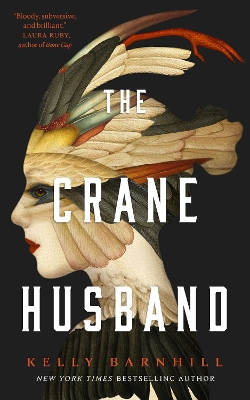Thank you NetGalley and Tordotcom for the chance to read and review the extraordinary piece, The Crane Husband by Kelly Barnhill!
At around 128 pages, The Crane Husband can no longer be called a novella. And yet this short novel weaves together a tale that other authors fail to do in 10 times that number of pages.
"Cranes are mean. Cruel, you know? Just ask any frog or fish in the pond. A crane is a predator just like any other predator—sneaky, and opportunistic. Not one of them would have the patience for weaving, or for beauty for its own sake. A crane would make someone else do it for him. A mouse maybe. Or a beautiful spider. He’d work it nearly to death, and then he’d eat it.”
One day, our unnamed narrators mother brings home a crane. Not a pet crane, but a crane the size of a man. While she imagines that the crane will leave soon, her mother adopts plenty of human and animal strays for short periods, it’s still odd to see it kiss her mothers neck and draw blood that her mother doesn’t notice. And things only get more intense from there on.
“It’s a sad fact about true love,” my mother told me once. “The sheep love me without ceasing, and that is why I am able to cause them pain—love is the path of least resistance, you see? It’s a lot more work to cause harm to someone who mistrusts you, or fears you. Or hates you. Love opens the city gates wide, and allows all manner of horrors right inside. This is why they don’t flinch when I come at them with something unpleasant.”
The family has always believed that mothers on the farm run away when their child turns 5 years old. The town has always believed that they are mad and run away with different men. Now that the farm is gone and our narrators father dead, the mother has remained; an artist with the practicality of a farmers daughter, when needed.
“Your mother doesn’t know these things,” he said, a note of pleading in his voice. “She has always been that way. She is an artist. Her feet barely touch the ground. I’ve been the one to keep her tethered to the earth. And now it’s your job. And you’re too young, and it’s not fair, but there it is.”
With that in mind it’s also important to remember that while this falls under magical realism, this is a story of abuse and neglect. There is a parentified 15 year old, and a 6 year old without much food. There is also the horrifying practicality at the end, the neglect of the school system, the way things play out. I honestly don’t know how to write about all of this in a way that does it justice.
To the mothers who flew away. And to those they left behind.
I also feel like The Crane Husband is a good way to sample things before diving right into When Women Were Dragons by the author as well. You’ll know what I mean when you’ve finished this book!
